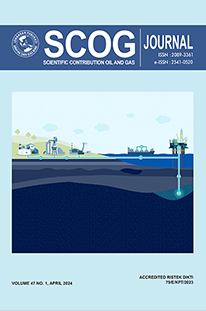Development of CO2 Hub-Clustering Management in The South Sumatra Basin
DOI:
https://doi.org/10.29017/SCOG.47.1.1607Keywords:
carbon capture and storage (CCS), utilization and storage (CCUS), CO2 source-sink matching, geographical information system, south sumatra basinAbstract
The escalating urgency of mitigating climate change demands immediate and effective strategies, with Carbon Capture and Storage (CCS) emerging as a pivotal solution. This scientific study presents a systematic and quantitative approach to selecting carbon dioxide (CO2) storage sites, focusing on the petrochemical industry in South Sumatra as the CO2 source, with annual emissions reaching 3.5 MtCO2. A comprehensive screening process was executed, employing 14 distinct criteria, each assigned a weighted score, to ensure the inclusion of technically feasible CO2 capture and storage options. Notably, the emphasis on Subsurface Data Analysis, encompassing vital factors such as storage reservoirs, boundary zones, traps, potential injectivity, prospective storage resources, and existing seismic data, served as a cornerstone in enhancing the robustness of our assessments. The research successfully identifies 15 CO2 storage fields, with a total storage capacity of up to 475 MtCO2. This quantitative evidence underscores the substantial potential for large-scale CO2 storage within the study area. Furthermore, considering spatial dynamics, with two distinct scenarios within a 100 km and 200 km radius of CO2 emission sources, provided precise quantitative insights into the geographical distribution of these storage sites relative to emission sources. It is crucial to note that optimizing pipeline infrastructure and utilizing existing Right of Way (ROW) were quantitatively validated as cost-effective measures for CO2 distribution, which is especially significant given the urgency of implementing CCS. Spatial calculations supported the proposal of a 600-kilometer pipeline route, demonstrating the quantitative feasibility of leveraging existing infrastructure to facilitate extensive CO2 management. This research could help in understanding large-scale CO2 storage potential and provides valuable insights for CCS policy and business development in South SumatraReferences
Al Adasani, A., & Bai, B. (2011). Analysis of EOR projects and updated screening criteria. Journal of Petroleum Science and Engineering, 79(1–2), 10–24. https://doi.org/10.1016/j.petrol.2011.07.005
Asian Development Bank. (2019). Carbon Dioxide-Enhanced Oil Recovery in Indonesia (Issue December). https://www.adb.org/publications/carbon-dioxide-enhanced-oil-recovery-indonesia
Chauvy, R., Lai, Y., & Chen, P. (2022). A Geographical Source-sink Matching for Carbon capture and Utilization deployment in Taiwan. International Journal of Greenhouse Gas Control, 119(1), 103722. https://doi.org/10.1016/j.ijggc.2022.103722
Department of Energy & Climate Change., Global CCS Institute., & Asian Development Bank. (2013). Prospects for carbon capture and storage in Southeast Asia.
Fan, J. L., Xu, M., Wei, S., Shen, S., Diao, Y., & Zhang, X. (2021). Carbon reduction potential of China’s coal-fired power plants based on a CCUS source-sink matching model. Resources, Conservation and Recycling, 168(June 2020), 105320. https://doi.org/10.1016/j.resconrec.2020.105320
Madden, B., Florin, N., Mohr, S., & Giurco, D. (2021). Spatial modelling of municipal waste generation: Deriving property lot estimates with limited data. Resources, Conservation and Recycling, 168(January), 105442. https://doi.org/10.1016/j.resconrec.2021.105442
Matejicek, L. (2017). Assessment of Energy Sources Using GIS. In Assessment of Energy Sources Using GIS. https://doi.org/10.1007/978-3-319-52694-2
PT Pertamina (Persero) Refinery Unit III Plaju. (2020). Laporan Kinerja PT Pertamina (Persero) Refinery Unit III Plaju 2020. 135. https://www.pertamina.com/Media/Upload///LK-PERTAMINA-RU-III-2020.pdf
PT Pupuk Indonesia (Persero). (2021). Laporan Keberlanjutan PT Pupuk Indonesia Tahun 2021.
Raza, A., Gholami, R., Rezaee, R., Rasouli, V., & Rabiei, M. (2019). Significant aspects of carbon capture and storage – A review. Petroleum, 5(4), 335–340. https://doi.org/10.1016/j.petlm.2018.12.007
Rikalovic, A., Cosic, I., & Lazarevic, D. (2014). GIS based multi-criteria analysis for industrial site selection. Procedia Engineering, 69, 1054–1063. https://doi.org/10.1016/j.proeng.2014.03.090
Turan, G., Zapantis, A., Kearns, D., Tamme, E., Staib, C., Zhang, T., Burrows, J., Gillespie, A., Havercroft, I., Rassool, D., Consoli, C., & Liu, H. (2021). Global status of CCS 2021. Global CCS Institute, 1–43. https://www.japanccs.com/wp/wp-content/uploads/2021/10/0-4-GCCSI_Jarad-Daniels.pdf
Usman, U., Saputra, D. D., & Firdaus, N. (2021). Source Sink Matching for Field Scale CCUS CO2-EOR Application in Indonesia. Scientific Contributions Oil and Gas, 44(2), 97–106. https://doi.org/10.29017/scog.44.2.586
Downloads
Published
Issue
Section
License
Copyright (c) 2024 SCIENTIFIC CONTRIBUTIONS OIL AND GAS (SCOG)

This work is licensed under a Creative Commons Attribution 4.0 International License.
Authors are free to Share — copy and redistribute the material in any medium or format for any purpose, even commercially Adapt — remix, transform, and build upon the material for any purpose, even commercially.
The licensor cannot revoke these freedoms as long as you follow the license terms, under the following terms Attribution — You must give appropriate credit , provide a link to the license, and indicate if changes were made . You may do so in any reasonable manner, but not in any way that suggests the licensor endorses you or your use.
No additional restrictions — You may not apply legal terms or technological measures that legally restrict others from doing anything the license permits.














